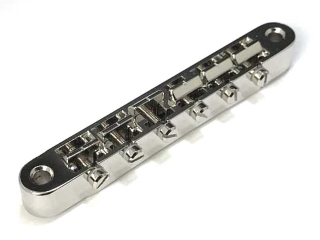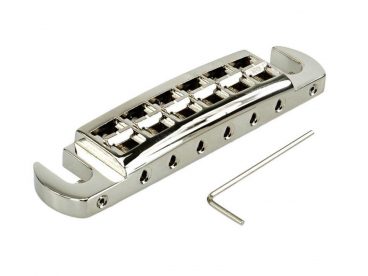In the guitar parts market, you’ll hear a lot of words thrown around that might not mean a lot. In fact, if you are new to the world of guitar upgrades and customization, some of the words thrown around might even make the process of sourcing the right parts for your instrument more of a challenge than it needs to be.
One term that you will hear a lot in your search for a new bridge is “Tune-o-Matic”, which is a blanket term used to describe the typical Gibson style bridge system with individually adjustable saddles for each string allowing the user to intonate each string separately.
Both the ABR and Nashville bridges are types of Tune-o-Matic bridges. The main differences between the two can be found in their adjustability.
ABR Bridges
The ABR style bridge is the “classic” bridge style. If you own a vintage Les Paul, Reissue or Custom Shop model, you will most likely have an ABR style bridge installed. The bridge posts are 6-32 threaded rods and will be screwed directly into the body wood. The thumbwheel is a separate part of the post that the bridge sits on and moves up and down as the thumbwheel is turned. Many players gravitate towards this style bridge as it’s the typical configuration on vintage and vintage reissue Gibson style guitars both functionally and visually. The Faber Guitar Parts ABR style bridge meets all the vintage criteria and is the perfect upgrade for your ABR-1 equipped guitar.
Nashville Bridges
The Nashville style bridge is similar to the ABR and is found on many more Gibson guitars than the ABR-1. The main difference between the two bridges is in their widths and how they are mounted to the body. The Nashville style bridge has a bridge post that screws into a metal body bushing, with an integrated thumbwheel. Height adjustment is carried out by turning the thumbwheel, which moves the entire assembly up or down as it screws into the metal body bushing. There are several reasons why players do not like the Nashville bridge system:
1) The bridge itself is significantly wider than the ABR-1 bridge which not only doesn’t look historically correct but also requires the tailpiece to be set higher than normally desired so that the strings can clear the back of the bridge. The Faber Guitar Parts ABRN Nashville replacement bridge has the full adjustability of a classic Nashville style bridge, but with the sizing of the ABR-1 bridge so you can have more control over the adjustability of your tailpiece.
2) The loose fit of the body bushings and height adjustment posts, which are made of an inferior zinc alloy. Faber Guitar Parts Nashville Conversion Posts are made from steel, which has proven to be much more effective at providing better tone and sustain. In the case of the Faber iNsert and BSWKIT conversion posts, those are mounted directly into the body wood, with a separate thumbwheel for height adjustment, which more closely resembles the ABR-1 system;
3) Nashville bridges are mounted with the saddle screw heads facing the tailpiece, which is another departure from the vintage look. Faber bridges are designed to have the saddle screw heads facing the pickups which allow for easier adjustment. Furthermore, Faber bridge saddles can be removed and turned to provide perfect intonation. In most cases, however, the standard saddle orientation is adequate to get perfect intonation.
Wraparound Bridges
Wraparound bridges differ from the Tune-o-Matic style bridges in that a wraparound serves as the bridge AND tailpiece in one unit. The strings get fed into a wraparound bridge away from the neck and are wrapped over the top back up the neck. If you own a vintage Gibson guitar from the 1950s you might have a one piece wraparound bridge that will resemble a tailpiece. That type of wraparound eventually evolved into what is known as the “compensated,” or “lightning bolt” design, with the goal of providing better intonation. Faber offers a range of 100% lightweight aluminum compensated Wraparound bridges with our Tone-Bar or TPWC wraparounds. Our TPW wrap is an accurate representation of the 50’s original style wraparound, and many owners of vintage guitars with uncompensated wraparounds purchase a Faber compensated wraparound to use in their daily playing, for better intonation, while preserving their original vintage wraparound.
We also offer a fully adjustable wraparound style bridge, with adjustable saddles for perfect intonation, from our Wraptonate product range.
No matter your particular need in wraparound bridges, Faber® has it.











